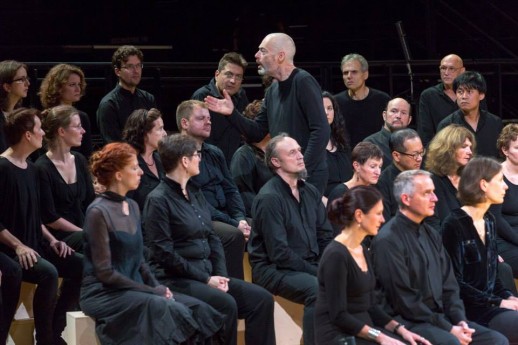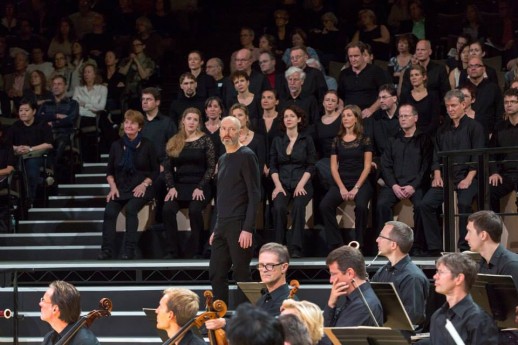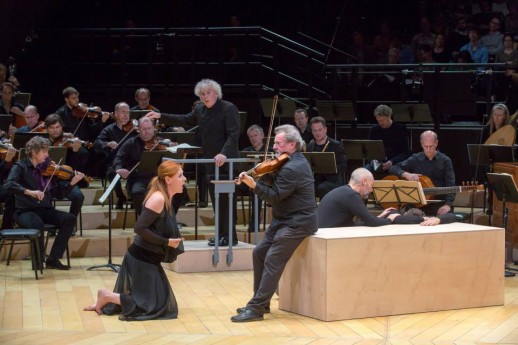

Featuring a group of (mostly) impressive soloists and accompanied by no less than the Berlin Philharmonic conducted by Sir Simon Rattle, the two-performance run quickly sold out becoming this fall’s most sought-after ticket. Although there may have been a few defections at intermission, I didn’t see a single person leaving Wednesday’s performance early, a testament to the power of Sellars’s deceptively simple concept.
Inspired by the uniquely enveloping design of the Philharmonie, the orchestra’s home in Berlin, an awe-inspiring physical environment was created for the event. Surrounded by high bleachers on all sides, a small stage at the center of the Armory featured the Philharmonic divided into two groups with an exemplary continuo band of organ, cello, lute and bass set between them. The superb 66-member Rundfunkchor Berlin was also split into halves with each choir member sitting on a cube of blond wood on risers. Several other larger boxes, one of which became both the table for the Last Supper, then Jesus’s tomb, were the production’s only props.
Sellars’s Handel and Mozart stagings at the PepsiCo Summerfare at SUNY Purchase during the 1980s were transformative events in my early opera-going experience. I most particularly remember a 1987 Così fan tutte so quietly shattering that it forever transformed my view of that opera. One lesson learned during those yearly visits to Purchase was to mostly ignore his logorrheic writings about his productions—the notorious “Trump Tower” Nozze di Figaro was accompanied by eight-or-so single-spaced pages of ruminations about what he was up to. Happily the program for St. Matthew Passion featured a director’s note of just three short paragraphs.
Since that white-hot enfant terrible period of the 80s, Sellars’s productions have become quieter, more ruminative, if no less intense. His comments about this Bach production (along with his companion staging of Bach’s St. John Passion) have emphasized “ritualization”: these great works are neither of the concert hall nor of the theater. Instead, they offer an opportunity for a communal “ritual” of remembrance and transformation.

Sellars’s most radical act of “ritualization” is his Evangelist who here not simply recounts events but reenacts many of them. It is he—embodied by the riveting, gaunt figure of tenor Mark Padmore—who is kissed by Judas, who blesses the bread and wine, who is whipped and scorned. Jesus, sung by baritone Christian Gerhaher, remains apart throughout, intoning his pronouncements from the rear of the orchestra during Part I, then from the very back the audience during the final scenes. This dramatic strategy has a curious paradoxical effect: it both distances us from the agonies of Christ’s passion centuries ago while at the same time asks us to identify with an Evangelist who through his re-experiencing these traumatic events makes them live for us in the present.
It’s nearly impossible to conceive of this vision without the devastating, selfless Padmore in one of the more remarkable performances seen in New York in many a year. I’ve been a fan since the early 1990s when he burst on to the scene with Les Arts Florissants excelling in works by Purcell and of the French baroque. More recently he’s become an acclaimed lieder interpreter and exponent of the operas of Benjamin Britten.
I, however, was in the minority earlier this year in disliking his strained and muted Vere in the Glyndebourne Billy Budd performed at the Brooklyn Academy of Music. His searing Evangelist brought forth no such reservations. Clad in a simple black shirt and pants and onstage throughout the long evening, Padmore alternated between an ethereal haut-contre-like high voice and a raw, earthy tenor that mirrored both the transcendence and the agony of the story. Acting with supreme simplicity and concentration, he both comforted the devastated Peter and writhed in agony as mezzo Magdalena Kozená sought to soothe his back from the whip’s lashes.
Gerhaher’s mellifluously beautiful baritone and sensitive use of words proved ideal for Jesus, but the other two male singers were sadly off-form. Tenor Topi Lehtipuu made some ungainly sounds in his aria in the evening’s first half; his contributions later proved more congenial but one remained conscious of a voice under severe strain. Eric Owens’s initial appearance was similarly alarming: “Gerne will ich mich bequeman” was all a brutal rasp. He, too, improved particularly in the enthralling “Mache dich” but he never seemed truly comfortable either vocally or dramatically, perhaps as he had not appeared in the original production where his part was taken by the now-retired Thomas Quasthoff.

Joined by the sterling Boy Choristers of St. Thomas Church, Berlin’s choir, led by Simon Halsey, was remarkable, singing from memory and acting with specificity and individuality. While Rattle’s tempi throughout the evening bordered on the expansive, the numerous chorales were taken quite briskly but the chorus’s breadth and unanimity made them among the evening’s high points. The luxurious sound of members of the Berlin Philharmonic proved almost too lush at times; one wonders what this enterprise might have sounded like with Rattle conducting the period-instrument orchestra he has long championed, the Orchestra of the Age of Enlightenment.
Many of the orchestra’s top musicians were spotlighted by Sellars’s production. When an aria featured one or more obbligato instruments, the players came forward and engaged in a dialogue with the singer. Particularly impressive were violinists Daniel Stabrawa and Daishin Kashimoto and, playing the rare oboe da caccia, Dominick Wollenweber and Christoph Hartmann. Yet, for me, this choice distracted from the purity of the staging by calling attention to musical “performance.” But perhaps “performance” is the ritual? It was a puzzling element of the concept that I haven’t yet resolved.
During the 1990s Jonathan Miller presented his very different staging of the Matthew Passion at several venues around the world including BAM where I saw it in 1997. Rather than Padmore’s intensely suffering figure, Miller’s Evangelist—tenor Rufus Müller—was a simple, humane story-teller. I remember being very moved by the intimate world created in that production—more moved than I was by Sellars’s more complexly aestheticized vision.
Happily for those unable to get (or afford) tickets to the very short run at the Armory, the Berlin Philharmonic has released on its own label video recordings (on both DVD and Blu-ray) of the Rattle-Sellars St. Matthew Passion from a performance given at the Philharmonie on April 11, 2010 (with Quasthoff and a pregnant Tilling).
Also available is the (shorter) St. John Passion given this past spring by many of these same artists. Sellars’s St. John takes a more traditionally “dramatic” approach this time by having bass Roderick Williams as Jesus interact directly with the other performers (including this time a very pregnant Kozená). These beautifully shot and packaged editions can be ordered directly from the Berlin Philharmonic.
Christopher Corwin is the reviewer formerly known as DeCaffarrelli.
Photos © 2014 Richard Termine

























Comments